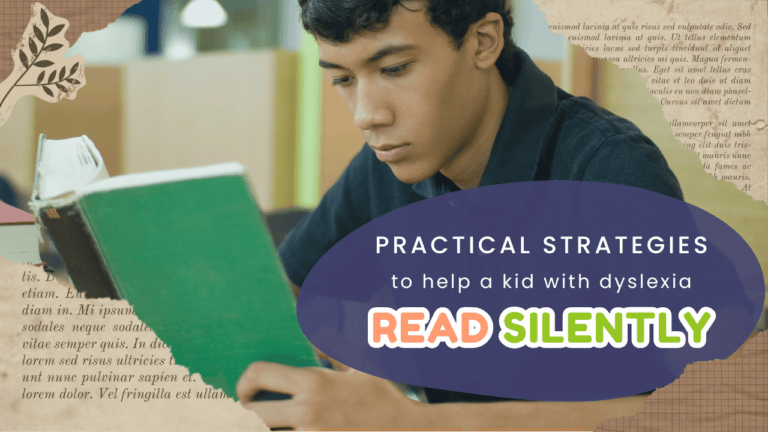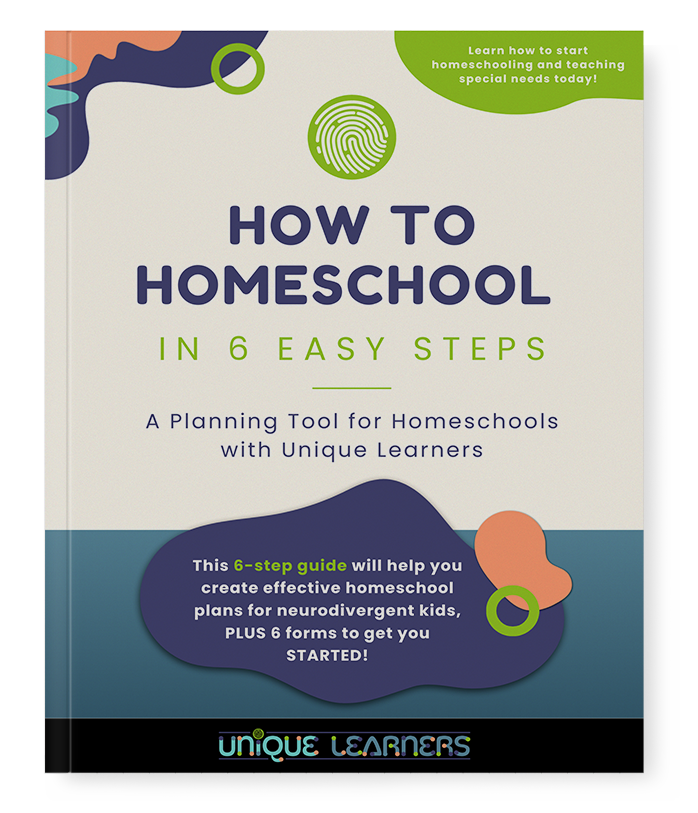One of the many freedoms in homeschooling is to teach our children to read the way they best learn. The process can take longer for some kids, especially those with auditory processing issues, like dyslexia, autism, or CAPD. The transition from reading aloud to the world of silent reading can often feel like leaping across a chasm. We would love our kids to read silently as an adult, yet many kids with reading difficulties continue needing to read aloud into high school. Within this challenge lies a golden opportunity for growth and empowerment. This blog post delves into innovative strategies to bridge the gap between oral reading to read silently, offering insights that illuminate the path towards mastery.
Consider the mind of a child with dyslexia as a uniquely wired instrument, one that might play harmonies others don’t immediately hear. Parents and educators alike often search for the right keys to unlock the potential within, to help these young learners not only read but to thrive in their academic journey. Through a combination of patience, tailored techniques, and an understanding of brain-based learning, the transition to read silently becomes not just achievable but transformative. Join us as we explore the gentle art of guiding these children towards the serene, yet powerful, experience of reading silently, ultimately allowing them to turn their struggle into a silent, yet triumphant, symphony.
WARNING! This article gives you effective, specific, strategies for teaching reading. Read carefully, and you will surely find a strategy that will fit your young reader.
Understanding Dyslexia and its Impact on Reading
Dyslexia is a learning disorder that affects the way individuals process language, particularly when it comes to reading. It is important to understand that dyslexia is not a reflection of intelligence or effort; rather, it is a neurological condition that requires specific strategies and support to overcome its challenges in symbolic processing.
For children with dyslexia, the act of reading can be an arduous task. They may struggle with decoding words, recognizing letter sounds, and comprehending written text. These difficulties can make the transition from oral reading to silent reading particularly challenging.

When children read aloud, they are able to rely on auditory cues and the feedback from their own voice to assist them in understanding the text. However, when they are asked to read silently, they must rely solely on their visual processing skills and internalize the information without the aid of sound. This shift can be overwhelming for children with dyslexia.
So what do we do?
Challenges Faced by Kids with Dyslexia in Transitioning to Read Silently
The transition from oral reading to being able to read silently poses several challenges for children with dyslexia. One of the main difficulties lies in decoding words without relying on auditory cues. This sounds strange since dyslexia is embedded in auditory processing skills most of the time.
#1. Auditory Processing Training
The first suggestion for making the transition to reading silently is to address the underlying issues. The absence of auditory feedback can make it harder for them to stay engaged with the text and comprehend what they are reading. Computer-based auditory processing training can be highly effective in training the brain to increase auditory processing speed, discrimination of sounds and words, auditory memory, working memory, and so many other brain skills that are essential to reading efficiently. Unique Learners is a certified provider of Fast ForWord, and we can get your child set up in the program to start auditory processing training. Fill out the inquiry form below so we can get connected about Fast ForWord!
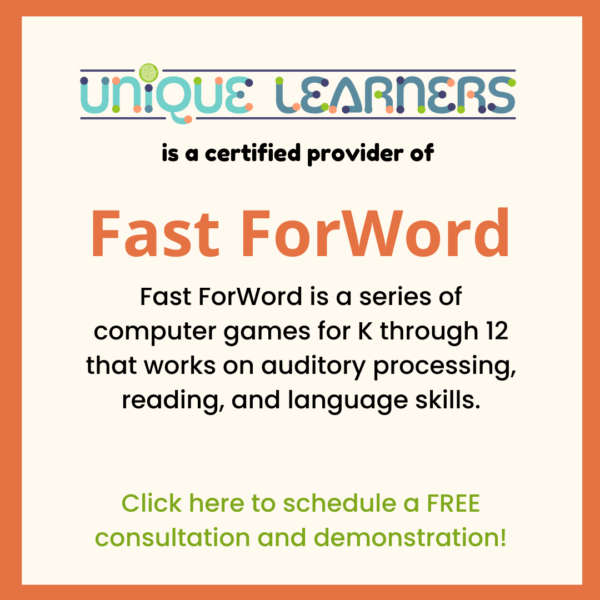
Interested in using Fast ForWord with your child?
Fill out the form and we will get back to you with information about Fast ForWord!
#2. Vision Therapy and Visual Processing Training
Sometimes a reading issue is due to visual issues. Vision Therapy can be helpful if a student complains that the words jump around on the page or they see double of the words. Of course, the first line of intervention is to be sure your child’s visual acuity is clear by checking with an optometrist to see if your child needs glasses.
A Vision Therapist is a different provider who helps assess and provide exercises to strengthen eye muscles to hold the eyes steady and work together to converge at an appropriate distance. If your child has done Vision Therapy in the past, it is fine to revisit those exercises to keep the muscles strong and engaged, just as you would working out at a gym. If you live in a larger city, you are likely to find a Vision Therapist in your area.
Visual Processing Training is a bit different than Vision Therapy. While Vision Therapy works on the mechanics of the eyes, Visual Processing Training works on how the brain deals with the images that are received from the eye. In addition, dyslexic readers may have difficulty maintaining focus while reading silently. Attending to Print, Working Memory, and Vigilance (an Attention skill) are all important brain skills needed to help a young reader transition to reading silently. There are several excellent Visual Processing Training programs available for various age groups. If you are interested in learning more about Visual Processing Training, click here.
Furthermore, dyslexic readers may experience frustration and anxiety when faced with the expectation to read silently. The fear of making mistakes or not understanding the text can hinder their progress and discourage them from embracing this new skill. Although we can use timing to monitor the increase in reading rate, there are specific strategies to reduce the stress of being timed. Some students do not respond well to timings at all. Before expecting more speed, be sure your child can read smoothly aloud and makes fewer than about 5 mistakes in whatever the current reading level is.
Importance of Transitioning to Read Silently for Children with Dyslexia
While the challenges of transitioning to reading silently may seem daunting, it is a crucial skill for children with dyslexia to develop. Silent reading allows individuals to read at their own pace, without the pressure of reading aloud or keeping up with others.
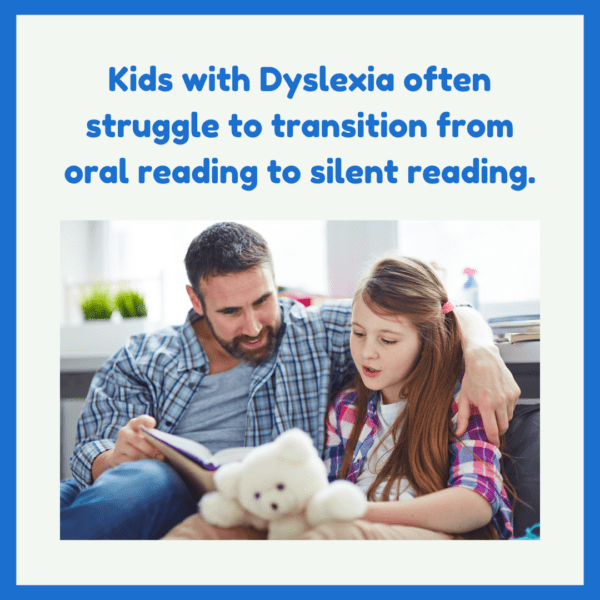
By transitioning to silent reading, children with dyslexia can also improve their reading comprehension skills – eventually, but it takes practice! When they are able to focus solely on understanding the text without the distraction of decoding each word, they can better grasp the meaning and context of what they are reading.
In addition, reading silently opens up a world of possibilities for dyslexic readers. It allows them to explore various genres and topics independently, fostering a love for reading and nurturing their intellectual curiosity.
Tailored Techniques for Teaching to Read Silently
When introducing silent reading to children with dyslexia, it is important to employ tailored techniques that cater to their specific needs.
Visualization Strategies
One effective approach is to start with short passages or books that are BELOW their instructional reading level, ensuring that the text is not too overwhelming. Check for comprehension with oral reading. Many kids work so hard just to decode the words, so teach techniques for making visual images in the mind or creating a mind movie of the action in a story. If your child has difficulty making pictures in their head, have them draw pictures. This strategy can be carried over as the child starts to practice reading silently.
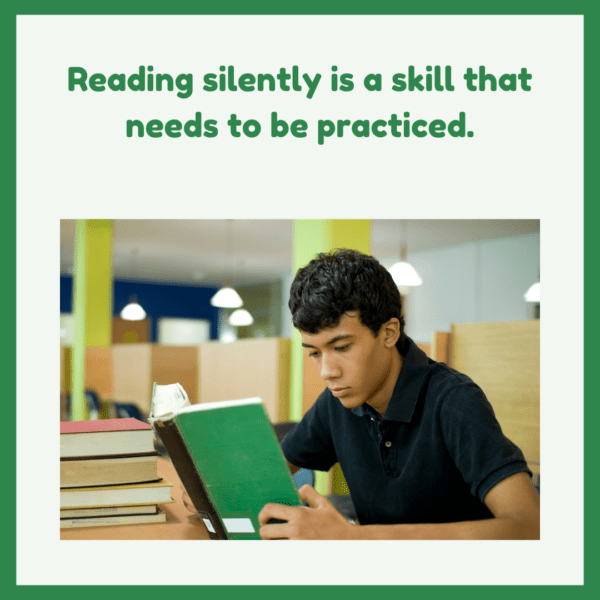
Homeschool parents can also provide dyslexic readers with visual supports, such as highlighting important information or using color-coded bookmarks to help them stay focused and track their progress. These visual cues can serve as anchors, guiding their eyes through the text and enhancing comprehension.
Another helpful technique is to encourage self-monitoring while reading silently. Children can be taught to ask themselves questions about the text, summarize what they have read, or make predictions about what might happen next. This self-reflection promotes active engagement with the material and enhances comprehension.
Narration is integral using a Charlotte Mason approach to homeschooling. Regardless of your homeschool approach, you can have your child state their version of the Main Idea, give one or two details, or ask for their opinion about a character.
Creating a Supportive Environment for Dyslexic Readers
Supportive environments play a crucial role in helping children with dyslexia transition to read silently successfully. Teachers and parents can create a safe space where mistakes are seen as opportunities for growth and where individual progress is celebrated.
It is important to foster a positive mindset around reading by providing dyslexic readers with books that align with their interests and abilities. Offering a variety of genres and formats, such as graphic novels or audiobooks, allows them to explore different avenues of reading and find joy in the process. You don’t have to assign or insist a specific book is read. Book baskets and “strewing” are popular homeschool practices that put books where kids are going to discover them and are surrounded by reading material.
In addition, providing ample time for independent reading allows children with dyslexia to practice their silent reading skills at their own pace without feeling rushed or pressured. This dedicated time helps build confidence and reinforces the idea that reading silently is an achievable goal.
Embracing Multisensory Learning Approaches
Multisensory learning approaches are highly effective in supporting children with dyslexia during the transition to read silently. These strategies move in a progressive sequence that moves through various stages of weaning off oral reading.
First, encourage your kiddo to practice a story or passage that has already been read to you and mastered. Suggest the child whisper read the story in a different room from you. If the child is nervous about making mistakes, just reply that it is ok because the story is already known. The child can either try to sound out words or underline them to show you later. Then make yourself busy so your child must practice independently – it’s a great time to do a load of laundry!
Second, when your child is getting settled with whisper reading, suggest moving to moving their lips but not blowing air as in whispering. Long ago, I had teachers insist I not whisper or move my lips as I was reading a story. We’ll deal with that at the next step, but for now, we are progressing through gradual stages and lip moving eliminates the outer auditory sense and moves it to the movement of forming the words with the mouth.
Third, now we encourage the child to stop moving lips and think of the words in their mind. Some kids can still “hear” the words in their heads. Others have a very difficult time at this stage depending on the severity of the dyslexia symptoms. If your child learns to silent read by lip moving, this is still way better than reading orally as an adult. Remember though, that it takes practice. Model, encourage, praise, and practice.
Fourth, this strategy can be used alongside the third strategy. Providing a paper copy and an audiobook of the same book can allow your child to follow along with the audiobook reader to hear what a faster pace sounds like and to read silently as the child’s part. This strategy requires monitoring at first because many kids prefer to just listen rather than to use their eyes to follow along. Multisensory input often requires more effort from a learner with a language-based disability, so they tend to avoid the auditory input or the visual input. However, the transition can be accomplished quickly if the child will use their eyes to read along as the story is read by a fluent reader.
Finally, some kids will be able to read silently without the need to “hear” the words in their heads. True silent reading is a visual only task that eliminates the need for auditory input to access the meaning of the words. I have found that kids who can read orally at 150 words per minute without mistakes can usually be encouraged to practice reading silently with their eyes only. Be aware that comprehension typically drops at this stage. That’s OK. Keep practicing. As the silent reading fluency increases, comprehension will catch up more slowly. It’s also fine to do repeated readings to practice reading silently to improve comprehension.
Some students with milder reading issues can learn to use modified speed reading techniques by using finger tracking patterns and monitoring reading speed. It helps if students are aware they will be timed, yet don’t have the pressure of a stopwatch, a ticking kitchen timer or a start of “Ready, Set, Go!” Make the timing discreet and hidden if possible. Graphing results can be very powerful when done correctly. You can grab our FREE Silent Reading Graphs & Comprehension Chart here!
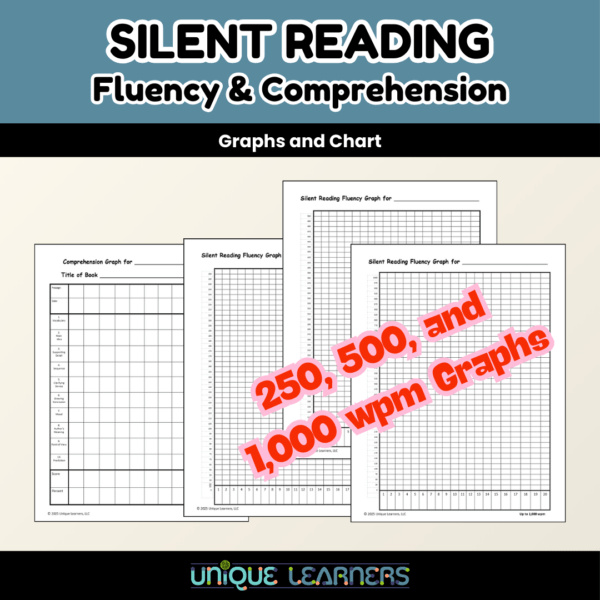
For students who find transitioning to read silently nearly impossible, incorporating technology tools that provide audio support can be beneficial for dyslexic readers. Audiobooks are very popular with many adults who have no reading difficulties, so the stigma has disappeared. Text-to-speech and speech-to-text software can intervene for teens with more severe dyslexia or autism who need reading and spelling support.
Utilizing Technology Tools to Aid in the Transition Process
The digital age has brought forth a wealth of technology tools that can aid in the transition to read silently for children with dyslexia. These tools provide additional support and scaffolding, making the process more accessible and engaging.
Cognitive training, or brain training, using acoustically modified speech with reading and language skills can improve auditory processing speed and understanding of spelling, grammar, and reading silently. We have found Fast ForWord to be one of the most successful auditory training programs that impact reading skills! If you are interested in learning more about Fast ForWord reading and language training for dyslexia, feel free to drop us a message!
Text-to-speech software, for example, allows dyslexic readers to listen to written text while following along visually. This auditory reinforcement helps bridge the gap between oral and silent reading by providing additional support in decoding unfamiliar words.
In addition, e-books often come equipped with features such as adjustable font sizes, background colors, and highlighting options. These customizable features allow dyslexic readers to tailor their reading experience to their specific needs, enhancing their comprehension and overall reading enjoyment.
Celebrating Milestones and Progress in Silent Reading
Transitioning from oral reading to silent reading is a significant milestone for children with dyslexia. It is important for educators and parents alike to celebrate the progress made along this journey.
Recognizing achievements, no matter how small, boosts confidence and motivates dyslexic readers to continue working towards their goals. Whether it’s completing a chapter book independently or successfully decoding a challenging word, each accomplishment deserves recognition and praise.
By celebrating milestones, we instill a sense of pride in these young learners and reinforce the idea that hard work pays off. This positive reinforcement fuels their determination and encourages them to persevere through any difficulties they may encounter.
Conclusion: Empowering Kids with Dyslexia to Read Silently
The transition from reading aloud to reading silent may present unique challenges for children with dyslexia, but it is a journey that can be navigated successfully with the right strategies and support. By understanding the impact of dyslexia on reading, employing tailored techniques, creating supportive environments, and utilizing technology tools, we can empower these young learners to embrace the world of reading silently.
Through patience, perseverance, and celebration of milestones along the way, we can help bridge the gap between oral and silent reading for children with dyslexia. By doing so, we enable them to unlock their full potential as readers and embark on a lifelong love affair with books.
We, at Unique Learners, are here to support your journey in teaching your child with learning differences. We love to partner with you, the homeschool parent, by teaching you the strategies that work – often without changing the curriculum you prefer. We can also support you with brain training or tutoring support directly with your child. Join our Facebook group, Homeschool Help for Special Needs, or send us an email telling us what you most need!
Grab your FREE e-book guide to revamp your homeschool for success!
Are you new to homeschooling, or just wanting a fresh start? Download our FREE How to Homeschool in 6 Easy Steps guide and get valuable insights from Sue’s 30+ years of experience as a special educator and homeschool mom of 4!
Want to know about new products and blogs?
Join our email newsletter to be the first to know about a new homeschool and special needs blog, and new products from our shop! Sign up for only the newsletter, or grab your FREE How to Homeschool in 6 Easy Steps guide and you will also be added to the newsletter!
Also, join our Facebook group!
Join our new Homeschool Help for Special Needs Facebook group! It is a place for homeschool moms to ask questions about homeschooling a child with special learning needs, share teaching and curriculum ideas that have worked (and those that bombed), and be real about the unique challenges of homeschooling with special needs. If you want to join us, be sure to answer the member questions to help us keep this private group secure. Join us now!
